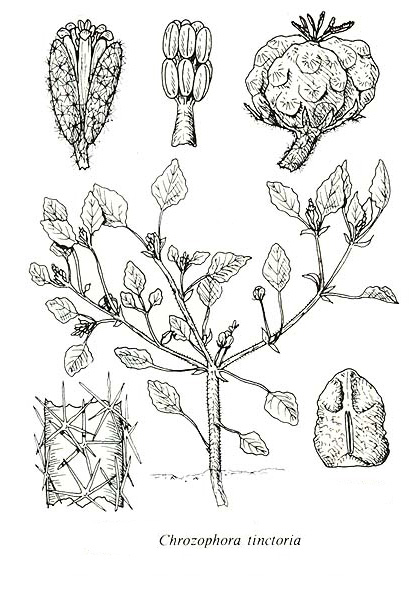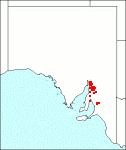Family: Euphorbiaceae
Chrozophora tinctoria
Citation:
Andrews in Adr. Juss., Euphorb. Gen. 84 (1824).
Synonymy: Croton tinctorium L., Sp. Pl. 2:1004 (1753).
Common name: Turnsole, dyers litmus plant.
Description:
Plant green or grey-green, rather thinly stellate-tomentose to glabrescent; stems to 50 cm, more or less branched; leaves alternate, on distinct petioles 1-7 cm long (in S.Aust.), lamina ovate to rhombic, 2-6 cm or more long and 1-6 cm wide, entire or sinuate-dentate, subobtuse, cuneate at the base, with 2 circular elevated glands at the base and c. 1 mm across, slightly darker above, paler beneath with distinct reticulate-pinnate venation; stipules filiform, 1-2 mm long.
Male flowers to 20, on upright peduncles, each subtended by a filiform bract 3-5 mm long; calyx and petals c. 4 mm long, calyx lobes lanceolate, deeply cut; stamens 9-11, usually 10 in 2 whorls; anthers linear, c. I mm long, dehiscing longitudinally; female flowers 1-4, on peduncles 5-15 mm long, short in flower, extending in fruit, first erect, latter drooping; all 10 calyx lobes free, narrow-triangular with filiform tips, c. 2 mm long, persistent in fruit, more or less stellate-tomentose.
capsule distinctly 3-lobed, 6-8 mm across, tuberculate, usually covered with scale-like peltate hairs, breaking into 3 1-seeded fruitlets, styles rotate, 2-fid; seeds 3, more or less ovoid, c. 4.5 x 3.5 mm, rough, with a white crust over the grey-black tubercles.

| Chrozophora tinctoria habit, male flower, column of stamens, female flower, branch with stellate hairs and seed.
|
Image source: fig 399b in Jessop J.P. & Toelken H.R. (Ed.) 1986. Flora of South Australia (4th edn).
|
Published illustration:
Andrews in Jussieu (1824) Euphorb. Gen. t. 7, fig. 25; Pax (1896) Natürlichen Pflanzenfamilien 3, 5:figs 27, 28F-G.
|
|
Distribution:
|
S.Aust.: FR, EP, NL, YP, SL. N.S.W.; Vic. Originated in southern Europe, Mediterranean and the Middle-East. Probably introduced as a weed in crops.
|
Conservation status:
naturalised
Flowering time: Jan. — April.
|

SA Distribution Map based
on current data relating to
specimens held in the
State Herbarium of South Australia
|
Biology:
Formerly a source of a dye used for colouring linen as well as pastry and cheese. Some specimens from the Wirrabara district (NL) are rather glabrescent with black fruits on which the scale-like peltate hairs are rather flat and stellate, similar to the not fully developed peltate scale-like hairs found in the other places.
Author:
Not yet available
|

